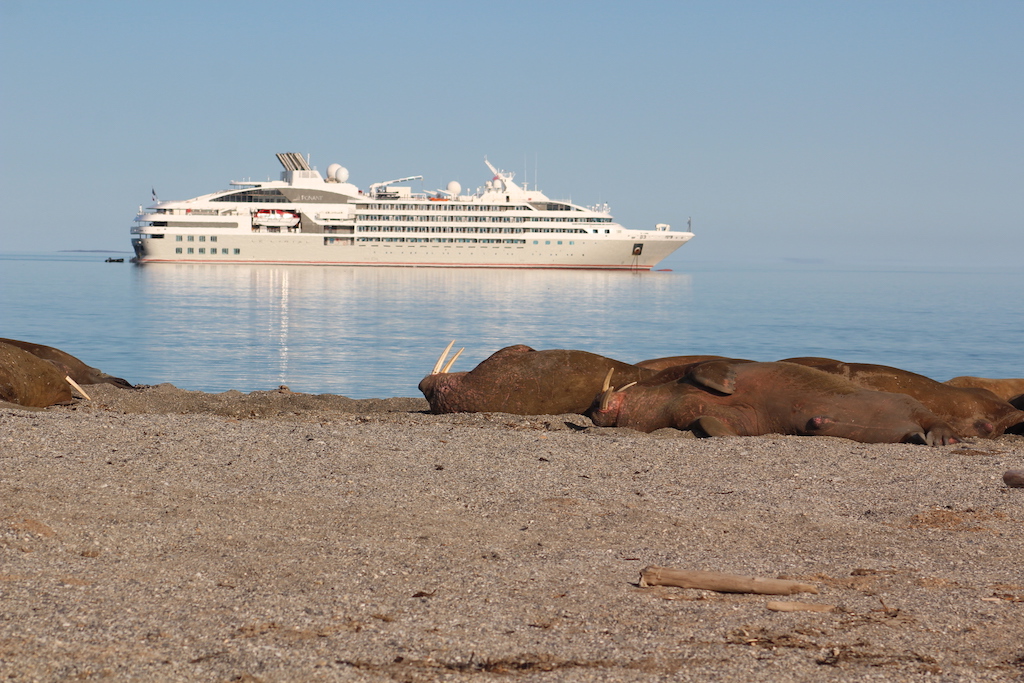A Walrus bachelor party and a hundred thousand special birds

Day 2 searching for polar bears in the Arctic with Abercrombie & Kent
By Eileen Ogintz
It must have been some bachelor party. Most of the 80-plus guests are laying in the black sand, intermittently groaning. A few others are taking a dip in the water.
We are on day four of our two week Abercrombie & Kent Arctic Cruise Adventure “In Search of the Polar Bear.” This afternoon, we have taken the zodiacs from the ship to Wahlbergoya, an island in the Hinlopen Strait, named after a 19thCentury Swedish botanist who lived when Sweden dominated scientific activity and exploration in the Svalbard Archipelago. Today, Norway administers most of the territory.
[Photos by Andy Yemma]

The party goers are a group of bachelor walruses who live in the Arctic Ocean and subarctic seas of the Northern Hemisphere. Full grown, they weigh more than 4,400 pounds and are iconic for not only their bulk but their long white tusks.
They are lazing on the sand, we learn from our guides, after getting their fill of clams in the shallow seabed. We do see a few who are still eating, grabbing the mollusks, and then sucking them out from the inside.
How do we know they are a bachelor party? It turns out the males, from the time they are three or four, live in a herd together separate from the females, our guide, David Burton, who has a master’s degree in polar studies, explains.

When they are on the sand, they like to touch each other, Burton tells us. “They are very social,” he said. This likely also better protects them from polar bear attacks. Just in case, some of our expedition leaders are stationed around a perimeter with eyes out for the bears. But we don’t see any.
What is the difference between seeing wildlife in Antarctica and the Arctic?
In Antarctica, there is such an abundance and it is predictable where they will be, explained Augustin Ullmann, our assistant expedition leader who has had extensive experience guiding in both.
“In Antarctica the wildlife is all there…you know where,” he explained. “I the Arctic, mammals are more skittish. They have been hunted for hundreds of years and now fear of humans is in their DNA.”
I understand better what he means the next morning when we are out in zodiacs exploring the “White Island” of Kvitoya. We are far northeast in the Svalbard archipelago when there is a polar bear sighting. But where?
“Looks like a white rock,” one person says.

“It’s to the left of the ice in the water,” says our zodiac driver and naturalist guide Russ Manning. He tries hard to maneuver our zodiac so we can see the bear in the distance up against the white ice but I can’t tell if I’m looking at a bear or a rock. Andy took several photos of what looked like a “white rock” with his long lens. When we got back to the expedition ship we had a better look. The photo is above.
“Antarctica is a shining star from the beginning,” he says. “The Arctic is more fog and mystery. We have to be a lot more patient here and have a high tolerance for frustration.”

He says this as he drives our zodiac earlier this morning to explore Alkefjellet, located inside the Noradaust Svalbard Nature Reserve.
The 320-foot high cliffs resemble medieval castle spires where more than 100,000 guillemots are perched on every ledge, with thousands of breeding pairs jockeying for space. The air and the water are filled with the birds flapping their wings, flying, and screeching. Though not related, they resemble flying penguins.

We wonder if they are complaining about neighbors infringing on their space and privacy. That may well be as, Ullmann explained. “They are fighting for room on the cliffs.” The juveniles leave the nest before they are two months old, as soon as they have been taught to fly. The birds return here to nest but not to the same spot but not the same nest
As for whether Antarctica is better to visit than the Arctic.
“Who do you love more,” Ullman asks, “Your mother or your father?”

